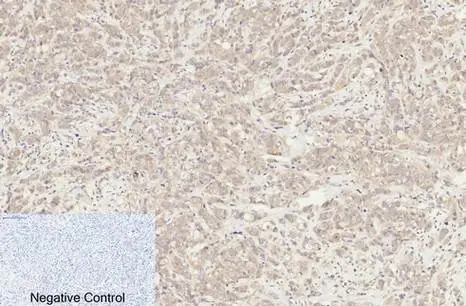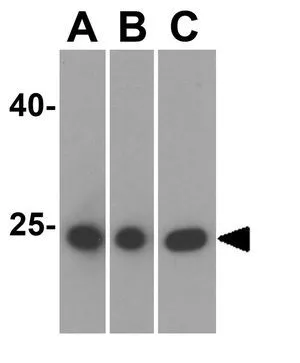
IHC-P analysis of human breast cancer tissue using GTX86893 Caspase 8 (cleaved Asp384) antibody.
Caspase 8 (cleaved Asp384) antibody
GTX86893
ApplicationsWestern Blot, ImmunoHistoChemistry, ImmunoHistoChemistry Paraffin
Product group Antibodies
ReactivityHuman
TargetCASP8
Overview
- SupplierGeneTex
- Product NameCaspase 8 (cleaved Asp384) antibody
- Delivery Days Customer9
- Application Supplier NoteWB: 1:500~1:1000. *Optimal dilutions/concentrations should be determined by the researcher.Not tested in other applications.
- ApplicationsWestern Blot, ImmunoHistoChemistry, ImmunoHistoChemistry Paraffin
- CertificationResearch Use Only
- ClonalityPolyclonal
- ConjugateUnconjugated
- Gene ID841
- Target nameCASP8
- Target descriptioncaspase 8
- Target synonymsALPS2B, CAP4, Casp-8, FLICE, MACH, MCH5, caspase-8, FADD-homologous ICE/CED-3-like protease, FADD-like ICE, ICE-like apoptotic protease 5, MACH-alpha-1/2/3 protein, MACH-beta-1/2/3/4 protein, MORT1-associated ced-3 homolog, apoptotic cysteine protease, apoptotic protease Mch-5, caspase 8, apoptosis-related cysteine peptidase, caspase 8, apoptosis-related cysteine protease
- HostRabbit
- IsotypeIgG
- Protein IDQ14790
- Protein NameCaspase-8
- Scientific DescriptionThis gene encodes a member of the cysteine-aspartic acid protease (caspase) family. Sequential activation of caspases plays a central role in the execution-phase of cell apoptosis. Caspases exist as inactive proenzymes composed of a prodomain, a large protease subunit, and a small protease subunit. Activation of caspases requires proteolytic processing at conserved internal aspartic residues to generate a heterodimeric enzyme consisting of the large and small subunits. This protein is involved in the programmed cell death induced by Fas and various apoptotic stimuli. The N-terminal FADD-like death effector domain of this protein suggests that it may interact with Fas-interacting protein FADD. This protein was detected in the insoluble fraction of the affected brain region from Huntington disease patients but not in those from normal controls, which implicated the role in neurodegenerative diseases. Many alternatively spliced transcript variants encoding different isoforms have been described, although not all variants have had their full-length sequences determined. [provided by RefSeq, Jul 2008]
- ReactivityHuman
- Storage Instruction-20°C or -80°C,2°C to 8°C
- UNSPSC12352203
References
- Zhang L, Liu B. Sapylin inhibits lung cancer cell proliferation and promotes apoptosis by attenuating PI3K/AKT signaling. J Cell Biochem. 2019,120(9):14679-14687. doi: 10.1002/jcb.28729Read this paper


![WB analysis of Wild-type (WT) and Caspase 8 knockout (KO) HeLa cell extracts using GTX01015 Caspase 8 antibody [GT1152]. Dilution : 1:1000 Loading : 25microg](https://www.genetex.com/upload/website/prouct_img/normal/GTX01015/GTX01015_20200327_WB_1_w_23053121_243.webp)
![WB analysis of HEK293 cell lysate using GTX30244 Caspase 8 antibody [FLICE 4-1-20]. Lanes 1 : inactive Caspase 8 Lane 2 : active Caspase 8 Dilution : 1:500](https://www.genetex.com/upload/website/prouct_img/normal/GTX30244/GTX30244_1376_WB_w_23060722_596.webp)


![ICC/IF analysis of HeLa cells using Caspase 8 antibody [EPR162] at a dilution of 1:100.](https://www.genetex.com/upload/website/prouct_img/normal/GTX63075/GTX63075_ICCIF_1_w_23061202_434.webp)